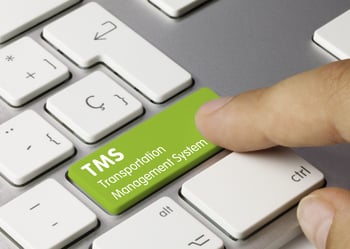
The Tough Decision of Implementing a Transportation Management System During COVID-19
 The COVID-19 pandemic has left many shippers and logistics companies questioning whether it is prudent to continue to push forward with implementing a transportation management software (TMS) system or put the project on hold. Each company has their own story, but they all have the same challenge of whether now is the “right” time for them.
The COVID-19 pandemic has left many shippers and logistics companies questioning whether it is prudent to continue to push forward with implementing a transportation management software (TMS) system or put the project on hold. Each company has their own story, but they all have the same challenge of whether now is the “right” time for them.
The decision is not getting any easier as the fear of a COVID-19 second wave is putting even more doubt into the decision makers’ minds, as virtually every aspect of business operations have been affected by the coronavirus pandemic.
Add to the difficult decision is the number one question we are asked as companies are vetting our TMS technology team is how can they successfully implement a new transportation management software system with a remote workforce. Digging even deeper on the the question bring even more questions like:
- Can a remote team effectively bring together the resources required to drive through configuration and implementation?
- How can we bring all the players that touch a TMS implementation into the discussion to vet out all the requirements and participate in the configuration stage to ensure they get what they need for their team?
- Will training be effective for individuals working from home and how can we be sure everyone is ready on go-live day?
- What will be the mechanism and tools necessary during the go-live stage to help our team have a successful launch?
Again, those are just some of the questions going through executives minds.
 Some companies have gotten around the remote workforce issue because they have come to realize remote work is here to stay. These companies have determined that they can and will be as effective or more so with a remote workforce as they were within an office environment, so anything they would have done pre-COVID-19 will be done now.
Some companies have gotten around the remote workforce issue because they have come to realize remote work is here to stay. These companies have determined that they can and will be as effective or more so with a remote workforce as they were within an office environment, so anything they would have done pre-COVID-19 will be done now.
With the background of the issue defined, let’s we walk through the questions and current TMS market conditions leaders can run through their decision prism on whether their action will elevate their company’s success and drive long term business value, while trying to understand the risks added by executing such a project at this time.
Will Your Business Survive COVID-19?
The number one question to ask is whether your company will exist after the pandemic.
If the answer is no, then start planning the shutdown and move on to another article.
How Far Along is the Project?
 Our technology team has found companies at three different stages of their TMS project:
Our technology team has found companies at three different stages of their TMS project:
- Just starting through the discovery and vetting phase of a TMS.
- The team has signed the TMS software and implementation agreement and is in some phase of configuration and implementation.
- The TMS project has been put on hold during user acceptance testing, training and go-live.
Cost and time commitments are significantly different at these various stages of a TMS system implementation project. At the earlier stage, where the TMS team is assembling the TMS requirements document, the cost and time is minimal, while the latter stages of implementation and go-live will be the most resource heavy time and budget busting.
With that said, if your company is considering a new TMS or implementing one for the 1st time, it doesn’t hurt to start the gathering requirements and evaluating vendors. The investment is limited and one can quickly roll into cancelling or delaying the actual start of the project.
As for those that are in the implementation phase, the decision is a bit harder. Resources, cost, possible travel and the team working remotely all need to be considered. Once at this stage, we are finding cost to be the number one constraint, as the group has already found the remote workforce to not be that much of an issue.
There is no shame in asking your TMS vendor to suspend the project because of the concerns, but there may be associated costs. Our suggestion is to understand if there are additional costs to putting the project on hold or other contingencies that may play out once the project is restarted.
At this point, be as open and transparent as possible with your TMS integration partner. They have seen this before and know the contingencies and additional cost to consider. You may also be surprised to find the implementation partner and / or the TMS vendor themselves will step in and defer or shoulder some of the cost.
 Quite often the vendor will be willing to concede some because they want to keep their staff actively engaged with customers, so they have enough money coming in to keep their team employed. For them, the struggle is they know the difficulty in finding high quality IT professionals that know their software platforms. With that said, the last thing they want is to reduce their staff because there is no guarantee they will be able to get them back when the market takes off.
Quite often the vendor will be willing to concede some because they want to keep their staff actively engaged with customers, so they have enough money coming in to keep their team employed. For them, the struggle is they know the difficulty in finding high quality IT professionals that know their software platforms. With that said, the last thing they want is to reduce their staff because there is no guarantee they will be able to get them back when the market takes off.
If you are near the completion of the project, the decision is again different. Cost and team involvement will be the highest at this phase. Virtual teams and training is at a whole new level today with video conferencing technology and the tracking ability within the TMS to measure the effectiveness of training by employee. With that in mind, don’t let the thought of not having people onsite be a reason to hold back your TMS implementation.
Even if you are almost to the finish line and budgets need to be tightened, we again recommend being open and transparent about the situation with your TMS vendor and implementation partner. You may be surprised what options they will make available to help. Remember they are trying to hold their team together in these slower times and they also want to get some work done before the peak TMS purchase spree hits the market.
Before closing out this section and with much of it about price negotiations, the one point to make is to tread lightly on asking for concessions on prior billings. The pricing flexibility will come from work to commence, not historical. The prior billings have already been recognized and accounted for, while the budget items moving forward can be managed and flexed easily if the TMS vendor knows about them in advance.
Does the Leadership Team Agree the TMS is a Priority and to What Level
 All successful projects need corporate sponsorship and with a TMS touching every aspect of a company’s success makes this even more critical. In the decision process of moving forward you will need to take the time to dig deep into the level of commitment to the priority to bring in a new TMS at this time.
All successful projects need corporate sponsorship and with a TMS touching every aspect of a company’s success makes this even more critical. In the decision process of moving forward you will need to take the time to dig deep into the level of commitment to the priority to bring in a new TMS at this time.
Questions to ask to ensure the TMS is a top initiative both during and after COVID-19:
- How important is a new TMS to the business?
- Will a new TMS help to keep the company viable and competitive during difficult times like COVID-19?
- Does a new TMS have the ability to springboard their company to the next level when the pandemic is behind us?
- What new business risks are being taken on with a new TMS implementation that would otherwise not occur if stayed the current course?
- What are the risks to the business if a new TMS is tabled or completely removed from the horizon?
- If the world falls under another pandemic, which many are saying is a real possibility, will a new TMS put your company in a better position the next time around?
After going through the above decisions, it’s time to push forward with the core leaders in your organization for a full commitment that includes empirical factors / measurements that would be established at the beginning to keep the project moving, even if there is an unexpected shift in the market conditions from COVID-19. The reason to take on this angle of questioning with the key leadership is you want to establish the high water marks that indicate the company is “taking on too much water” and needs to be put on hold. The purpose is twofold:
- If the high water marks are fairly low, then maybe the commitment is not as strong as you thought it to be, which would be troublesome.
- The TMS project team does not to be constantly second guessing and therefore losing its focus as they wonder if the project will continue on to completion.
 As part of the viability question, one needs to understand the budget and people that your company is willing to assign the project. This will also help to access the level of commitment because you are essentially asking the leadership to put a financial and resource commitment.
As part of the viability question, one needs to understand the budget and people that your company is willing to assign the project. This will also help to access the level of commitment because you are essentially asking the leadership to put a financial and resource commitment.
If the answer to all the above questions reinforces the need for a transportation management system, the next set of questions are all about the commitment to hold a project team together to make the idea of a new direction a reality.
- How confident is leadership that they will be able to support an adequate project team that your organization can afford to maintain?
- As part of understanding what the TMS implementation project team looks like, as the impact of COVID-19 continues, you'll also need to understand if all the stakeholders have time to dedicate to this project.
- Finance, Customer Service, Operations, Sales and Purchasing all need to be aware of the project and be willing to also be a part of the team for a successful implementation.
- As part of this discussion, understand a TMS is more than about freight. A properly thought out and execution of a top tier TMS system will change the entire supply chain network of a company, so do not forget to include all stakeholders that will be impacted by the project.
- Do you have all the tools in place, so the project team can do the work from home successfully?
- Will all project team members have a home working environment that is conducive to this type of work? Do they have the space? Do they have the ability to dedicate the hours often required in the user acceptance testing and go-live stage?
- Obtaining the hardware and software tools is the easy part to this question. The harder side of this question can be a sensitive topic because it can be quite different depending on the employee.
Given all the other priorities caused by COVID-19, it may be impossible to get time with key decision-makers. A top three requirement for any software implementation is to have the buy-off and support of the C-suite, so if you are finding it difficult to get the attention of the leadership team to walk through the topics in this section, you need to strongly consider putting a pause on the project.
Dependencies & Contingencies Associated with the TMS Project
 With the importance and resource questions behind us, let’s finish up with possible dependencies and contingent requirements associated with a TMS system implementation that need to be addressed.
With the importance and resource questions behind us, let’s finish up with possible dependencies and contingent requirements associated with a TMS system implementation that need to be addressed.
- Is your current system being sunsetted or no longer supported?
- Does your company have a new customer that cannot be supported with the current TMS?
- Are there others systems coming online that require the functionality the new TMS alone can support?
- Under this same question, would it be more costly and risk the success of the other system if a new TMS was not brought into the company?
- Here is a twist. Are you aligned with a TMS that can support you in the COVID-19 times?
- Will this delay your critical TMS implementation?
- Software vendors are in the same situation as the rest of the market in that they too could have lost sales that cause them to lay off some of their team or not be able to perform at top levels while in a remote work environment.
- If you delay the project, when would your TMS vendor and implementation team be able to get back into the queue?
- It is a very real possibility that others may jump ahead of you, while you put your project in an indefinite holding pattern.
Time is of the Essence
 In a recent The Kiplinger Letter, specifically vol. 97, no.34, it indicated that IT spending is on track to be down 7% globally in 2020, but will then be followed by IT investment skyrocketing 20% to 30% through 2024. The areas of the most growth will be in cloud based platforms critical to customer success, business growth and remote work, which is an exact fit to a TMS platform that manages and optimizes a company’s supply chain.
In a recent The Kiplinger Letter, specifically vol. 97, no.34, it indicated that IT spending is on track to be down 7% globally in 2020, but will then be followed by IT investment skyrocketing 20% to 30% through 2024. The areas of the most growth will be in cloud based platforms critical to customer success, business growth and remote work, which is an exact fit to a TMS platform that manages and optimizes a company’s supply chain.
The reason to add this data point to the decision process is the Kiplinger Letter is pointing to a sizable resource issue ahead, which is the ability for even the largest TMS vendors to be able to on-board all the clients that will want to be up on their system.
After being in the TMS software market for a number of years, as a certified reseller and integrator for MercuryGate, we have found the market to have its ebbs and flows on demand. The flow of market demand often caused problems on getting everyone up on the TMS platform in the time they wanted because they all seemed to be buying around the same time.
With all that said, after going through the thought process of this article and you are at a point you know you want to move forward with a new TMS, are are on the fence when to start we highly encourage you to start now. You will avoid the coming log jam and you will be in a much better position to negotiate price.
Conclusion on Deciding to Implement a TMS
 All said, there is much to think about when considering to move forward or table your company’s TMS system project because even in the best of times companies have put their business in jeopardy with a poor implementation of a logistics and supply chain technology.
All said, there is much to think about when considering to move forward or table your company’s TMS system project because even in the best of times companies have put their business in jeopardy with a poor implementation of a logistics and supply chain technology.
The questions to ask are internal and external in nature and can be hard to draw a clear conclusion with because of other contingencies your logistics and supply chain teams do not control, but understand you are not alone out there. There are many resources to help you through the process.
We’d love to be one of those resources for you, so if interested in discussing this further please do not hesitate to reach out to us.
InTek is a Certified Reseller of the MercuryGate Cloud TMS, which is consistently ranked as a top 5 TMS in the market by Gartner in their Magic Quadrant Analysis.
Other TMS System Articles that May Be of Interest:
- A Complete Guide to TMS Freight Software: Market Capabilities and Solutions for Shippers
- Top 6 Cloud TMS Implementation Challenges During COVID-19
- Top 7 Remote Project Management TMS Implementation Essentials
- Best Transportation Management System (TMS) Software Packages
- Top 10 Transportation Management Software (TMS) Implementation Pitfalls to Avoid
- TMS RFP Template
- Gartner’s Magic Quadrant Analysis Key to TMS Buying Selection Process
If you're ready to take the next step, at InTek Freight & Logistics, we can help. Just tell us what you need and we'll discuss how our expertise can help with the unique shipping challenges your business faces. Rather do a bit more research first? View our Freight Guides for comprehensive articles and eBooks on all things freight and logistics.
Get Updates
Featured Articles
Categories
- Freight & Shipping Costs (54)
- Freight Broker (62)
- Freight Forwarder (2)
- Intermodal Transportation (186)
- International & Cross Border Logistics (43)
- Logistics & Supply Chain (422)
- Logistics Service Provider (77)
- LTL (39)
- Managed TMS (49)
- News (39)
- Supply Chain Sustainability (12)
- Transportation Management System (37)
- Truckload (122)
- Warehousing & Distribution (50)




